|
|

|

|

|
|
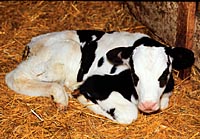
Breeding
Unlike beef producers, dairy farms make use of a breeding program which results in calves being born throughout the year, not just in the spring. Dairy cows will not produce milk until they have given birth, and then the cows produce milk for approximately 315 days. By breeding animals throughout the year, a continuous supply of milk can be maintained.
|
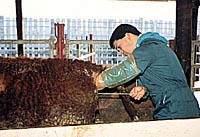
Dairy cattle are commonly breed by artificial insemination. By observing cows for behaviors which mean they are receptive to being bred, a technician can inseminate the cow with semen purchased from breeding companies.
This program has a number of advantages: There is no need to feed and keep bulls on the farm, andgenetics from almost anywhere in the world can be used to more rapidly improve herd production levels. The use of artificial insemination programs is not limited to dairy farming. It is commonly used in beef production, and in the swine and the poultry industry.
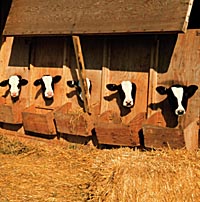
Multiple births for dairy cows are not generally desirable as they are in sheep production. Calves born as twins are usually smaller in size and they may be weaker. These calves may require additional care which can be expensive. If twin siblings are of different sexes, the female calf is usually sterile and will be unable to produce a calf and thus, any milk, when mature. This represents a large loss of invested time and money to the farmer.
|
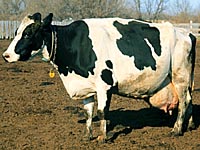
The goal of an efficient breeding program should be to breed each cow so that she produces a calf every year. After giving birth, the cow should be rebred within the next 2 - 3 months to ensure she will calve again with only a short break (2 months) during which she will not be producing milk. This break between when the cow is "dried off" (stops milking) and when she calves again is important because it gives the cow a chance to regain weight she lost during her lactation and for the growth and development of her calf. The image at the left is a lactating cow. Note the size of the udder.
|
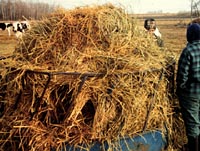
Nutrition
Dairy cattle are special animals classified as ruminants. Like other breeds of cattle and sheep, they have four stomachs which are specialized for the digestion of fibrous forages and concentrates. A diverse population of bacteria and protozoa inhabit one of the stomachs called the rumen. These microbes exist in a symbiotic relationship with the animal. Bacteria provide some of the digestive enzymes required to digest the fibrous carbohydrate found in hays and grasses, which the cow alone would be unable of using. The microbes of the rumen use this carbohydrate as an energy source for their growth and development. Over time, the microbes multiply and are washed out of the rumen. They are digested and used as food for the cow within the lower digestive tract. The presence of these microbes in the digestive tract of the ruminant permit it to use nutrients in feeds which monogastrics (animals with only one stomach) are unable to utilize.
Feeding the Calf
After birth, it is very important that the calf suckle from its mother within the first twelve hours. During this time, the mother's milk (colostrum) contains antibodies which the calf can absorb and use to protect itself from infection or illness while its immune system is developing. If too much time is taken before the calf sucks, it will be unable to use that antibodies contained in the colostrum. Calves with weak immune systems will be more likely to become ill and will not grow as quick, or as efficiently. Severe illness may even cause the death of the calf.
Nutrition for the newborn calf is very different from the adult animal. The specialized digestive tract populated by microbes is undeveloped and lacks function. Until the rumen develops and is populated by bacteria, the calf will be unable to make use of nutrients contained in hay or grass. Newborn calves normally depend upon their mother's milk for nutrients. This milk is the farmer's main source of income, and can't be sold if being used to feed the calf. Dairy calves are removed from their mother and housed separately so that they can then be fed a high quality milk replacer. This is a powder mixed with water and resembles milk. The difference is that many of the nutrients contained in the milk replacer are from plant sources instead of animal. Balanced with the correct proportions of protein, energy, vitamins and minerals the milk replacer is a cheaper source of feed than whole milk.
|
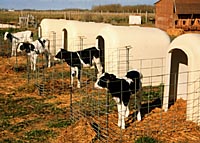
As the calf grows, it will be supplied with good quality hay and grain. The calf will learn to eat this feed and by about six weeks of age, will no longer be fed milk or milk replacer. Bacteria and other microbes from the environment will naturally populate the calf's rumen, and it will be able to make use of all the nutrients found in its new diet.
|
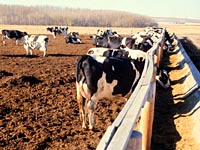
Feeding the Cow
The mature cow is fed a carefully formulated diet designed to meet its requirements, depending on its state of productivity. The mature cow can be sustained on a good quality forage alone, however, during the final term of pregnancy and throughout lactation, additional nutrients may be required. These are the times when additional nutrients are used for the growth of the calf and for the synthesis of milk. Animals with high requirements for nutrients can be fed a mixture of hay, silage and concentrates which may include barley, corn, rye, wheat, soybean meal or canola meal. Hay and silage are forages which are required to maintain a functioning rumen environment, while concentrates are used to supply additional energy and protein.
|
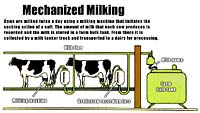
Milking
Dairy cows will only produce milk after they have given birth to a calf. Milk is intended to be the food source for the newborn calf. A highly nutritious product, the cow produces milk in its udder from the nutrients it eats every day. High producing cows may even mobilize body reserves of protein and fat to synthesize milk causing them to lose weight if there are not enough nutrients in its diet.
If a cow remains healthy, normal dairy farms will milk her for about 315 days, after which they "dry off" the cow by restricting her access to water for a day or two. The cow is then allowed to eat and drink so she can regain her weight to sustain her through her next lactation which will start about 2 months later.
|

Dairy cows are milked two or three times a day. Milked once in the morning and once in the afternoon, a dairy cow can produce up to 50 kilograms of milk per day at the peak of her lactation. Udders are washed and disinfected before the attachment of the milking claw to prevent contamination of the milk with mud or manure.
The milking claw is a vacuum system which massages the teat and encourages milk to flow from the udder. The milk flowing out of the udder moves through a series of pipes and stored in a large tank where it is refrigerated. When the tank fills, the milk is transported to a processing plant where it is pasteurized and processed into fluid milk and processed dairy products. |
|
|
|
|
|
